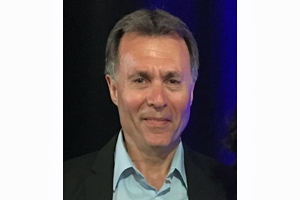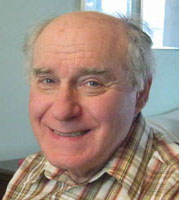Opinion
Are we going to be divided into two groups in society based on whose jobs are protected and whose not?
 By BERNIE BELLAN
By BERNIE BELLAN
As if the fear that any of us might contract COVID-19 isn’t bad enough, we’re rapidly devolving into a society that has two groups of workers: Those who have either been laid off entirely or taken cuts in pay or hours; and those whose jobs are fully protected, either by collective agreements or organizations that do not want to cut staffs. Recently, however, the Rady JCC was forced to lay off an astounding 160 employees – not including contract workers such as aerobics or yoga instructors. Is it fair that some workers in society in general, and within certain Jewish organizations specifically, are being spared any financial hardship while others are being so severely impacted?
When I asked the heads of several Jewish organizations whether they had laid off any staff, Rob Berkowits, executive director of the Rady JCC, was the only one to acknowledge that there had been layoffs.
The Jewish Federation of Winnipeg lists 17 staff on its website. On March 27 I posed this question to Elaine Goldstine, CEO of the Jewish Federation:
“In light of the news that federations all across N. America are cutting expenses and laying off staff, are there any plans to do the same in Winnipeg?
Speaking candidly, when so many sectors of society are feeling the economic pain – including me at my newspaper, why should Jewish community organizations here be spared that pain?
There is employment insurance available for laid off workers and assistance available for workers whose wages have been cut.”
Elaine responded: “At the time we are reviewing our budget.”
There has been no word since of any layoffs of staff at the Federation. What are all those staff doing now, I wonder?
When I asked Al Benarroch, excutive director of Jewish Child and Family Service, how his organization is operating, he indicated that staff are working from home. Yet JCFS has over 40 staff listed on its website, not including contract employees. Could they all be fully occupied?
There are other smaller agencies that receive some support from the Jewish Federation that have been forced to scale back operations and, in some cases lay off staff, but then we come to the real biggie: Gray Academy.
I’ve made no secret of the fact that I think Gray Academy is a hugely bloated operation, with seven full or part-time administrators in place for a school of only 486 students. (And remember, only six years ago the school had over 600 students. Why does it still need so many administrators?)
However, whereas in previous years one could see how many staff were actually employed by Gray Academy on its website, that information is no longer available to the public. If you want to see how many staff are employed by that school, you need login privileges to its wesite and “Login privileges at grayacademy.ca are available to registered Gray Academy families and staff only.”
What we do know is that no teachers anywhere are being laid off or are being asked to take reductions in pay even though schools are closed.
But, looking beyond our Jewish community, what about the wider community? I sent this letter to the Winnipeg Free Press on March 29, but it wasn’t published:
In a column last week Free Press publisher Bob Cox noted the extremely difficult financial situation in which many small businesses now find themselves as a result of the Coronavirus. He noted that the Free Press itself has taken a huge financial hit as a result of a drastic reduction in advertising.
As a small business owner myself – also a newspaper publisher, I can attest to the toll that much reduced advertising is having on my own business.
At the same time I couldn’t help but note the irony in the report that an arbitrator has ruled that the Winnipeg Police Service’s collective bargaining agreement with the City of Winnipeg is sacrosanct – and the idea that overtime earnings should not be included in determining a police officer’s pensionable earnings has been summarily dismissed by that arbitrator.
The thought has occurred to me that, if we weren’t living in a two class society before in Winnipeg, i.e., specifically City of Winnipeg and Winnipeg School Division employees as one class and everyone else as another class, the economic divide that is now taking place as a result of the Coronavirus is going to come into ever starker reality.
Here are some facts, obtained from readily available sources: The total City of Winnipeg budget for 2020 is set at $1.15 billion. There were some 1442 police officers in the Winnipeg Police Service as of 2019. The City of Winnipeg police budget for 2020 has been set at $304 million. The police budget will take up over 26% of the total city budget. More than 1,000 police officers earned over $100,000 in 2019.
There were 860 firefighters and 220 paramdedics employed by the City of Winnipeg in 2019. The average salary of a City of Winnipeg firefighter is $80,000. The firefighter and paramedic budget for 2020 has been set at $209 million. That amount represents 18% of the total city budget.
The Winnipeg School Division employed 1,924 teachers in the 2018-19 school year. The total amount spent on teacher salaries (not including substitute teacher salaries) came to $186,659,000. Thus, the average teacher salary in the Winnipeg School Division in 2018-19 came to $97,000.
While so many Manitobans are absorbing huge fiancial losses, either as a result of having been laid off their jobs or having their hours reduced, employees in the public sector are emerging totally unscathed. I have chosen to focus on employees whose wages will be reflected in our upcoming City of Winnipeg tax bills (including the portion allotted to the Winnipeg School Division) because a good many Winnipeggers are simply not going to be able to afford to pay those tax bills, either in part or in their entirety.
I am not intending to cast aspersions upon the quality of work performed by police, firefighters or teachers or the importance of their work. I merely wish to highlight the already huge disparity between certain coddled groups within the public sector here in Winnipeg and a great many other workers who are now facing severe financial hardship. If the gap between the public and private sectors wasn’t apparent to many of us before, what is happening now will certainly serve to show it in full dramatic detail. It is simply not fair that a great many members of the workforce are going to be totally spared any economic pain while so many others suffer grievously.
Bernie Bellan
As one final observation, I might note that Winnipeg Free Press workers themselves are now being asked to take huge pay cuts.
“Unionized workers of the Winnipeg Free Press and associated businesses will vote Sunday on a (sic.) “emergency, temporary” wage cut requested by the newspaper’s publisher, who says the publication needs the financial flexibility to survive a collapse in advertising revenue since the COVID-19 crisis took hold.
So, while the Free Press will not publish my letter nor, for that matter, have anything at all written about the enormouse gap that is now developing between haves and have-nots within society as a result of where you work, one wonders how much longer the Free Press itself can survive?
Features
Did the Jewish Federation’s stepping in to force the firing of BB Camp co-executive director Jacob Brodovsky lead to the further alienating of many young Jews from the community?

(June 8, 2024) Introduction: We received the following email from a young Jewish Winnipegger re the BB Camp controversy, which we’ve reported on extensively on this website. We thought it important to post the email as a separate piece rather than as an add-on to an article in which we printed other emails from readers expressing their disappointment at what happened to Jacob Brodovsky, the former co-executive director of BB Camp:
Dear Mr. Bellan,
Thank you for once again cutting through the noise with your April 23rd column, “What the sordid BB Camp affair says about our community.” Your clarity and courage in calling out our rush to judgment and our narrowing definition of “Jewish identity” are deeply appreciated, especially by those of us who feel increasingly alienated in Winnipeg.
I also want to share a troubling observation about one of the loudest voices attacking Jacob Brodovsky: theJ.ca. Their articles—bylines like “Ron East” or “TheJ.ca Staff”—are, in fact, almost entirely generated by artificial intelligence. They contain no verifiable sourcing, frequently hallucinate details, and appear to be little more than a far-right newsletter running smear campaigns under the guise of “journalism.” The entire BB Camp series reads like an AI trained on extremist talking points, regurgitated daily to bully our community into silence.
As a young Jew in Winnipeg, I—and many of my peers—are horrified by the transformation we’re witnessing. What was once a warm, progressive community is now dominated by:
Bigots and Bullies: Parents threatening to pull their kids unless the camp bows to extremist demands.
Florida-style Republican Judaism: A narrow, intolerant ideology portrayed as the only “true” Jewishness.
Collapsing Leadership: Our Jewish Federation leaders, including Jeff Lieberman, have shown they lack the vision or backbone to navigate this crisis.
We stand at a dangerous inflection point. Our community is on the verge of a total and irreversible fascist takeover—an outcome no amount of regret or retrospective apologies can undo.
Please consider reading firsthand accounts from community members who have bravely spoken out:
I know this letter is anonymous and won’t be published, but I hope you see it as proof that many of us are desperate for ethical, forward-looking leadership. Thank you again for using your platform to remind us what Jewish community should mean: diversity of thought, compassion for all people, and the moral courage to call out extremism—no matter where it comes from.
This was NEVER a community of far-right Israelis. This is a shame beyond words.
With gratitude and urgency,
A Concerned Young Jew in Winnipeg
Post script: We had heard from many different sources (who all asked to remain anonymous) that the Jewish Federation’s decision to force the BB Camp board to fire Jacob Brodovsky came as a result of pressure from one or more big donors to the Combined Jewish Appeal. We sent an email to Jeff Lieberman, asking Jeff whether the Jewish Federation’s decision to force the resignation of Jacob Brodovsky as co-executive director of BB Camp came as a result of a donor (or donors) to the Combined Jewish Appeal threatening to withdraw their donation(s) this year unless Jacob were fired. I don’t think anyone would be surprised to learn that Jeff did not bother responding to my request for information.
The Jewish Federation used to advertise elections to its board in The Jewish Post & News for many years, but no longer does so (in the Jewish Post). Instead, it submits a slate of new appointees to its board to members of the current board to be rubber stamped. Is it any surprise that the donors who contribute the most money call the shots for the Federation (which is as its always been. The only difference is the Jewish Federation and the Winnipeg Jewish Community Council before it used to operate with a patina of democracy. Sadly, that is no longer the case.)
We would urge anyone on the Federation board who could give information about what led the board to force the resignation of Jacob Brodovsky to contact us. We would give full anonymity, as we have to the writer of the above letter.
-Bernie Bellan
Local News
Is It Alberta’s Turn to Regulate Online Gambling? Looking at the Possibilities

Online gambling and betting in Canada is booming, with each province allowed to regulate its own space. Ontario, Canada’s most populated province, turned two this year after leading the way in April 2022. In what should motivate Alberta and other provinces, Ontario is already reaping the rewards, generating $100 million annually in gambling revenue. Will the local administration in Alberta do what is needed?
Talks have been rife that Alberta is considering going the Ontario way by having an open-licensing system. In July 2023, the minister for Service Alberta and Red Tape Reduction, Dale Nally, issued a mandate to make this province a hub of online sports betting and gambling.
Alberta Premier Danielle Smith recently asked Nally to cooperate with indigenous partners and other stakeholders to develop an online gaming strategy. The main focus will be on revenue generation and responsible gambling. In light of this, Nally said Alberta’s primary focus is becoming a “leading hub for iGaming” with streamlined regulations and low corporate taxes. Such conditions should position Alberta to become a leading iGaming destination.
A few weeks ago, the minister attended the ICE international gaming conference held in London. Together with Ontario’s Attorney General, Doug Downey, and other stakeholders, Nally participated in a roundtable discussion regarding the status of iGaming in Canada. CDC Gaming Reports also revealed that the discussion highlighted the success of iGaming in Ontario and how Alberta can emulate this success story.
Looking into the Alberta Budget 2024, it’s evident that state monopoly could soon give way to Canadian casinos to thrive in the province. Alberta took the first baby steps towards a more liberal gambling sector after setting aside $1 million for gambling. This budget will support the looming review of the Gaming, Liquor, and Cannabis Act and supporting Regulation. The idea is to review the entire regulatory framework to find more funding ways for Alberta charities and community projects.
Major operators like BetMGM, PointsBet, and PokerStars have since hired lobbyists to ensure commercial operators become a reality in Alberta. Speaking to investors and industry analysts in March this year, PointsBet CEO Sam Swanell tipped Alberta and British Columbia to legalize online betting soon. He noted that this could provide the much-needed expansion of that TAM.
Alberta is yet to take full advantage of online gambling despite being the country’s fourth-largest province, with around 4.3 million people. Smaller markets in North America, such as West Virginia and Connecticut, are already benefiting from commercialized online gambling. The good news is that noises about legal online gambling are getting louder in Alberta. It’s just a matter of when the government will make the announcement.
What Next for Online Gambling and Betting in Alberta?
Including a $1 million gambling review budget is definitely a step in the right direction. However, there’s still much to do to end Alberta’s long-standing gambling status quo. But at least the budget opens the door for further discussions and reforms regarding iGaming in Alberta. That discussion has been underway, although the momentum has increased in the last year or so.
As it stands, PlayAlberta.ca is the only regulated online gaming platform in Alberta. It’s a government-run website operated by the AGLC (Alberta Gaming Liquor and Cannabis). Besides casino games, this website provides sports betting and lottery-style gaming experiences. The legal sign-up age on PlayAlberta.ca is 18 years.
For Albertans who prefer more gambling freedom, the government doesn’t restrict anyone from joining offshore operators. Most gaming sites operating in Alberta are licensed in Curacao, the UK, and Malta. Compared to PlayAlberta.ca, these websites provide a more extensive variety of games, rewards, and general experience.
In conclusion, it’s just a matter of when Alberta will introduce an open-licensing market. This approach has proved to be a success elsewhere, especially in Ontario. A recent Ipsos report in Ontario revealed that only 13.6% of the residents prefer to gamble on offshore websites. Alberta could soon follow this path, although there’s much work to do to realize this dream.
Opinion
Hamas savages make no distinction between Israeli Jews, Arabs

By MYRON LOVE I remember many years ago attending a presentation by Simon Wiesenthal, the world’s leading Nazi hunter, during which he made the point that the focus of Holocaust education should not be on the number six million – the number of estimated Jews who were murdered – but rather on the 12 million martyrs – including other targeted groups such as the Roma, people who were gay, the mentally and physically handicapped and the many great many Slavic people who were also murdered. After the Jews, the Slavs were next on the list.
By focusing strictly on Germans killing Jews, he observed, it became too easy to make it out to be only Germans versus Jews – thereby making it easier for Holocaust deniers and absolving the other European peoples who were complicit in the killings.
Similarly, while we naturally mourn our Jewish brethren who were so horribly slaughtered on October 7, we need to also bear in mind that Hamas made no distinction in its murderous rampage between Israeli Jews and Israeli Arabs or between Israelis and foreign workers.
In a posting for The Gatestone Institute on November 30, Israeli-Arab journalist Khaled Abu Toameh noted that he Hamas terrorists who attacked Israel on October 7 did not slaughter Jews alone. The terrorists also murdered and kidnapped scores of Muslim citizens of Israel, including members of the Bedouin community. The terrorists’ murder spree made zero distinction between young and old, Muslim and Jew.
“Scores of Arab Israelis were wounded, murdered or taken prisoner,” he reported.
One such brave individual was 23-year-old Awad Darawshe, an Arab-Israeli paramedic who was on duty at the music festival near Kibbutz Re’im, which was among the first locations under attack. When the medical staff on site were ordered to flee, he insisted on remaining behind to treat the wounded.
Abu Toameh suggests that the paramedic thought that because he was Arab, he could reason with the killers. He was murdered nonetheless.
Another courageous Arab-Israeli that the writer noted, 50-year-old Abed al-Rahman Alnasasrah, was murdered by Hamas terrorists when he attempted to rescue people from the music festival. He was married and a father of six children.
Fatima Altallaqat, 35, from the Bedouin village near Ofakim, was murdered while working with her husband near the city of Ofakim in southern Israel. She was a mother of nine children, the eldest nine years old.
Abu Toameh quotes her husband as saying: “We’re a religious Muslim family and she wore the traditional headdress of a devout woman. It is inconceivable they [Hamas terrorists] could not see who was inside [the car]. They were five meters away from her as they passed.”
Forty bullets were fired into her.
Abu Toameh further cites the comments of Suleiman Zayadneh, brother and uncle, respectively, to four of the Arab-Israeli hostages, who describes himself “as proud to be a Palestinian and Muslim”.
‘The people who came to shoot and kill — they know nothing of religion,” the writer quoted Zayadneh as saying. “These [Hamas] people came and killed left and right.”
Abu Toameh went on to reference the words of Nuseir Yassin, a video blogger with 65 million followers. Two days after the massacre, he wrote: “I realized that… to a terrorist invading Israel, all citizens are targets. More than 40 of them [the murdered] are Arabs. Killed by other Arabs. And I do not want to live under a Palestinian government. Which means I only have one home, even if I’m not Jewish: Israel…. So from today forward, I view myself as… Israeli first. Palestinian second. Sometimes it takes a shock like this to see so clearly.”
Abu Toameh reported that “there have been many storie about reciprocal inter-communal generosity and heroism in the aftermath of this national tragedy, and they create hope for the future”.
He quoted a statement by the Darwashe Family:
“We are very proud of Awad’s actions… This is what we would expect from him and what we expect from everyone in our family — to be human, to stay human and to die human.”
Abu Toameh also quoted Ali Alziadna, four of whose family members were kidnapped, as saying that he was “touched by the outpouring of support” by other Israelis.
“People from all over the country have come to hug and support our family,” Alziadna said. “The entire nation is one family now.”
Abu Toameh pointed out that many Arab citizens of Israel serve as IDF officers and policemen, risking their lives for their fellow Israelis. Many are serving at the front lines, saving lives.
Undoubtedly, Abu Toameh suggested, one of the objectives of the Hamas massacre, in addition to slaughtering as many Israelis as possible, was to thwart normalization between Israel and Arab countries, especially Saudi Arabia. Hamas may also have aimed to damage relations between Jews and Arabs inside Israel.
”The terror group was, without doubt, hoping that we would witness another cycle of violence between Jews and Arabs inside Israel, similar to that which erupted in May 2021,’ Abu Toameh posited. “Then, Hamas succeeded in inciting a large number of Arab citizens of Israel to take to the streets and attack their Jewish neighbors and Israeli police officers.
“This time, however, the Arab-Israelis have not heeded the calls by Hamas. One reason is that Arab-Israelis saw, with their own eyes, how Hamas terrorists make no distinction between Jews and Muslims.
“Hamas has repeatedly demonstrated that it cares nothing for the well-being of Arabs and Muslims. From their luxury homes and hotel rooms in the safety of Qatar and Turkey, Hamas leaders give the orders to attack Israel and then sit back and let the world weep over the destruction they wrought upon their own people.
“On October 7,” Abu Toameh concluded, “Hamas metaphorically shot itself in the foot by showing the world, with unfathomably ghoulish pride, by way of Go-Pro cameras and other self-documentation, that it has neither a religious nor a secular-humanist set of values. Perhaps the Palestinians in the Gaza Strip should look at the Arab citizens of Israel and note how they enjoy equal rights, democracy, freedom of speech and a free media. If Palestinians wish to live well, like the Arab-Israelis, this is the time for them to get rid of Hamas and all the terror leaders who, for seven decades, have brought them nothing but one disaster after another.”
It is too bad that so many gullible fools in our Western societies refuse to open their eyes to the truth.


